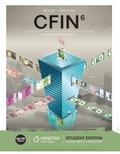
Concept explainers
(a)
Introduction:
Treasury bonds (T-bonds):
These bonds involve earning periodic interest up to maturity (greater than 20 years) and consider government debt securities that are issued by the Federal government of the country.
Expectations theory:
Based on long-term (current) interest rates this theory
To determine: The expected one-year interest rates in the second year by using the expectation theory when the interest rate on one-year treasury bonds is 0.4%, 0.8% on two-year bonds, and 1.1% on three-year T-bonds.
(b)
Introduction:
Treasury bonds (T-bonds):
These bonds involve earning periodic interest up to maturity (greater than 20 years) and consider government debt securities that are issued by the Federal government of the country.
Expectations theory:
Based on long-term (current) interest rates this theory forecasts the short-term interest rates for the future where an investor receives the same amount of interest by investing in two (one-year bond and two-year bond), one after the other year. It is useful to calculate the expected returns and differentiate the investment returns in business.
To determine: The expected one-year interest rates in the third year by using the expectation theory when the interest rate on one-year treasury bonds is 1%, 0.9% on two-year bonds, and 0.8% on three-year T-bonds.
Want to see the full answer?
Check out a sample textbook solution
- A firm needs to raise $950,000 but will incur flotation costs of 5%. How much will it pay in flotation costs? Multiple choice question. $55,500 $50,000 $47,500 $55,000arrow_forwardWhile determining the appropriate discount rate, if a firm uses a weighted average cost of capital that is unique to a particular project, it is using the Blank______. Multiple choice question. pure play approach economic value added method subjective approach security market line approacharrow_forwardWhen a company's interest payment Blank______, the company's tax bill Blank______. Multiple choice question. stays the same; increases decreases; decreases increases; decreases increases; increasesarrow_forward
- For the calculation of equity weights, the Blank______ value is used. Multiple choice question. historical average book marketarrow_forwardA firm needs to raise $950,000 but will incur flotation costs of 5%. How much will it pay in flotation costs? Multiple choice question. $50,000 $55,000 $55,500 $47,500arrow_forwardQuestion Mode Multiple Choice Question The issuance costs of new securities are referred to as Blank______ costs. Multiple choice question. exorbitant flotation sunk reparationarrow_forward
- What will happen to a company's tax bill if interest expense is deducted? Multiple choice question. The company's tax bill will increase. The company's tax bill will decrease. The company's tax bill will not be affected. The company's tax bill for the next year will be affected.arrow_forwardThe total market value of a firm is calculated as Blank______. Multiple choice question. the number of shares times the average price the number of shares times the future price the number of shares times the share price the number of shares times the issue pricearrow_forwardAccording the to the Blank______ approach for project evaluation, all proposed projects are placed into several risk categories. Multiple choice question. pure play divisional WACC subjectivearrow_forward
- To invest in a project, a company needs $50 million. Given its flotation costs of 7%, how much does the company need to raise? Multiple choice question. $53.76 million $46.50 million $50.00 million $53.50 millionarrow_forwardWhile determining the appropriate discount rate, if a firm uses a weighted average cost of capital that is unique to a particular project, it is using the Blank______. Multiple choice question. economic value added method pure play approach subjective approach security market line approacharrow_forwardWhat are flotation costs? Multiple choice question. They are the costs incurred to issue new securities in the market. They are the costs incurred to insure the payment due to bondholders. They are the costs incurred to meet day to day expenses. They are the costs incurred to keep a project in the business.arrow_forward
